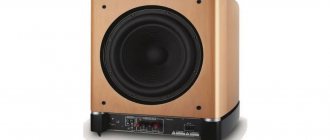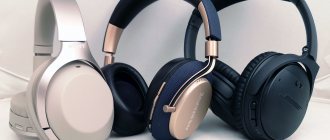Balanced circuitry has long gone beyond the category of purely professional and has become a mandatory attribute of High-End technology. Not long ago, the concept of “balanced” began to be actively applied to headphones and headphone amplifiers. To understand what it is and whether the circuit design is similar for balanced audio components, professional and high-end components, we will conduct a reverse engineering session and trace the signal path from balanced headphones to the output stage of the DAC, from which we receive an analog signal.
Four contacts
We know two things about balanced headphones. First, regular headphones can become balanced if you connect a special cable to them. Moreover, even headphones not initially declared by the manufacturer as balanced, turn into such when using the appropriate cable from a third-party manufacturer. As a rule, we are talking about in-ear headphones or full-size ones with a Y-shaped cable connection, in which the speakers of the left and right channels are not connected by a common “negative” cable. There can be a lot of examples of this, starting from High-End headphones like Audeze and Astell&Kern AK T5p, including high-quality Hi-Fi models like Sennheiser HD660 and ending with cheap QKZ “plugs” from Aliexpress.
This is how (literally) the signal is sent to the right and left channels of the headphones with a balanced connection. Two out of three contacts are used for signal transmission
The second fact is that the balanced cable and the output of the balanced amplifier have not three, but four contacts. The reason is still the same - the channels do not and should not have common wires. And again, you can find many examples both among High-End equipment and among budget Chinese Hi-Fi. Examples include the Bryston BHA-1F amplifiers as a High-End solution, a good example of a mid-budget Hi-Fi is the Musical Fidelity MX-HPA, and the ultra-budget class can be assessed by the SMSL SAP-10.
Complete symmetry
Now I suggest you look inside the balanced device. As a test subject, let's take the already familiar Schiit Audio Jotunheim, which is a fully balanced preamplifier, a balanced power amplifier and has additional modules in the form of a balanced DAC and a phono stage. Thus, we can observe all possible options for the balanced path.
Let's start with something simple. Connection to a balanced amplifier occurs using three-pin inputs and outputs on XLR connectors. The balanced connection circuit implies the presence of three signal conductors: “plus”, “minus” and “ground” (located in the middle). In fact, we see double the unbalanced circuitry.
As you can see, the left and right channels in a balanced connection have little in common, and with an unbalanced connection they would be connected by a “ground” wire
In an unbalanced circuit, the useful signal passes between “plus” and “ground”, and in a balanced circuit another signal line appears between “minus” and “ground” - a mirror reflection of the “positive” signal. Thus, the amplitude of the signal is doubled. However, the main positive effect arises due to the fact that various types of interference penetrating into the sound path from the outside are unipolar. Therefore, when interference arrives on the “plus” arm in phase, then in the “minus” arm it turns out to be in antiphase, and as a result we get mutual cancellation.
The whole essence of balanced circuitry: we parallel the positive and negative branches of the signal and completely eliminate all interference when adding signals at the output
From a circuit design point of view, one channel in a balanced amplifier essentially represents two ordinary unbalanced channels. Instead of a single transistor or op-amp operating between positive and ground, symmetrical pairs of transistors or op-amps are used, one operating on the positive side, the other on the negative side, with ground being the midpoint between them. Relatively speaking, we can take one stereo amplifier and turn it into a monophonic balanced amplifier, amplifying the “minus” arm, say, with the left channel and the “plus” arm with the right one.
The digital balanced circuit uses two DACs, both channels of one are occupied by the left channel, and the other by the right channel
Accordingly, looking inside the balanced device, we will see two sound paths with a symmetrical arrangement of elements. An important point: in a balanced circuit, each channel has its own “ground”, which is not connected to the “ground” of the other channel, while in an unbalanced circuit the “ground” is common and very often both channels are amplified in one chip or one lamp.
Unbalanced cable
An unbalanced cable has two wires: signal and ground, and only allows one copy of the signal to pass through. Because there is only one copy of the signal, this cable is easily susceptible to interference. Typically, the length of such cables does not exceed 6 meters; they connect the device, guitar and guitar amplifier.
Inside view: Beneath the rubberized outer protection of the unbalanced cable is a braided shield, which is a mesh of fine copper wires that wraps around the main signal wire. Braided shielding can be of different types, each of which has its own pros and cons in its ability to have different effects on noise and interference.
Between two worlds
The principle of operation of a balanced preamplifier in relation to a Hi-Fi system is generally clear. The XLR connector comes with three signal wires: plus, minus, and ground. The signal enters a symmetrical path and, after amplification, appears at the output with the same three-pin connector. Everything looks logical, but what happens at the beginning and end of the audio path? A balanced hi-fi power amplifier connects speakers with two rather than three terminals. Balanced headphones also use two rather than three contacts per channel. The signal source will also not necessarily be balanced. How does the balanced circuit work in this case?
Each output amplifier amplifies one half-wave of the signal, and they are added in the headphone dynamics
The circuitry of the final balanced amplifier is generally similar to the others, only in the final stage the acoustics or headphones are connected to the “plus” and “minus” outputs, and the “ground” is simply not used. Accordingly, one channel of a balanced power amplifier is the equivalent of two channels in an unbalanced configuration. Moreover, the load connection diagram is exactly the same as when the amplifier operates in bridge mode.
The two balanced zones behind the jacks are not two stereo channels, but two balanced channels. Feel the difference!
As an example of the implementation of balanced amplifier inputs, let's look at the optional upgrade modules that can be integrated into the balanced circuitry of the Jotunheim amplifier. One of them is a USB DAC, and looking at the board it’s easy to see that its circuitry is also completely balanced.
Two DACs and two balanced channels after them
It uses two DAC chips, each of which reproduces the “plus” and “minus” arms of one channel, followed by a recognizable symmetrical analog path. The second optional module is a phono stage, and this is where questions arise. The phono preamplifier by default has unbalanced inputs, but on the phono preamplifier board we see a symmetrical balanced path. How does this happen?
The unbalanced input is converted into balanced using operational amplifiers, then follows the same circuit
Just as a balanced signal can be turned into an unbalanced signal using only the positive side of the signal, it is possible to create a virtual midpoint between the positive and ground of the unbalanced signal, thereby giving rise to a balanced path.
What is balanced and unbalanced input
A balanced input is a symmetrical signal transmission over a pair of cables from one device to another. One wire transmits the signal in antiphase relative to the second cable. There is also a 2nd conductor of the symmetrical communication line - a neutral cable, called the signal “ground”. The advantage of the presented connection, relative to asymmetrical beams, is ultra-high noise immunity.
It has become possible to receive a stable communication signal without any interference if the active sound recording equipment is located at a remote distance. So, you can move the device away by several tens of meters and the acoustic quality will remain high. Balance lines are indispensable in the professional music field (concert stages, sound recording rooms), when it is necessary to ensure impeccable sound quality.
diagram of balanced and unbalanced inputs
The next advantage of such an input, as is commonly believed, is the standardized determination of the output/input characteristics of devices, for example, levels of electrical signals reduced to 0 dB, resistance. These parameters are also of great importance in the professional field, for example, when replacing equipment from different manufacturers. In a normal situation, adjustment of the signal levels is required; with a balanced input, this is not necessary.
If the distribution equipment has XLR connectors, this indicates a balanced connection. But whether it is “end-to-end” symmetry or whether it is formed through special circuit resolutions cannot be precisely determined. The “end-to-end” approach (from the signal source to the output stage of the audio amplifier, the symmetry of the elements of the connected equipment is preserved) is rare. As a rule, it is inherent in expensive equipment from well-known brands.
With an unbalanced input, 2 conductors are used - one carries the signal, and the other cable returns the current in the opposite direction. It must be remembered that the current can only circulate in a closed circle, which means that it is necessary to create a kind of loop (source-receiver), but this does not exclude interference. In one situation, when, for example, speakers are connected to an amplifier, the resistance of both the receiver and the source is relatively small. Here only very strong, powerful interference will be heard.
If the cable is short (interconnect), and it is also shielded (“ground” passes through the cable braid), there is also usually no excess noise. But if you have a very long microphone wire, in which the signal amplitude is measured in millivolts, the noise level is equal to the signal level, distorted sound cannot be avoided.
Degrees of perfection
One extremely interesting conclusion can be drawn from this: a device with a balanced headphone output does not necessarily have to be balanced throughout the entire audio path. In the situation with Schiit Audio Jotunheim, you can trace the entire circuitry and see with your own eyes that this device is truly balanced from start to finish. But nothing prevents you from making a USB DAC with a balanced headphone amplifier on one stereo DAC chip and with an unbalanced path inside. It is enough to install two bridge amplifiers at the output, and now we already have a balanced headphone output on an unbalanced device. This raises a completely logical question: does this make sense or is it a useless surrogate?
Manufacturers of amplifiers and sources do not have a common idea about the balanced connector, so headphone manufacturers adapt to everyone at once
Let's consider both options. Firstly, a fully balanced circuit design has an undeniable advantage, expressed in the low level of distortion that a symmetrical circuit provides. Secondly, in a fully balanced connection, the circuitry is symmetrical from start to finish. Both audio channels after the DAC or analog balanced input do not have a common “ground” and are not connected in any way, which guarantees maximum channel separation. In a circuit in which only the output stage is balanced (bridged), the channel separation will be less than in a fully balanced circuit, but still greater than in an unbalanced circuit.
Sennheiser headphones have two standard cables: balanced (connected, with a large jack) and unbalanced (lying next to the small 4-pin jack).
In both cases, dual amplifiers are used, which means doubling the output power. Thus, to obtain the same volume level, the amplifier will be half as loaded as a regular one. A double power reserve will have a positive effect on the sound dynamics and will become an additional means of improving quality, because at low load the amplifier has a lower level of its own distortion and noise, that is, it will sound cleaner and more detailed.
TEAC engineers decided that even with an unbalanced source, it would be a sin not to use dual amplifiers
A good example of implementing outputs in a balanced amplifier is the TEAC UD-503 model. Proprietary circuit design allows for the most efficient use of all possible use cases in any situation. With a balanced connection, the path is completely balanced.
Balanced circuitry is easy to recognize in any device: the same symmetry
With unbalanced, there is still an increase in the sound quality of balanced headphones thanks to proprietary technology with an active “ground”, when the signal turns into balanced at the input of the power amplifier. Finally, when connecting conventional three-pin headphones, each channel is amplified in bridged mode.
Which cable to choose?
We focus on the purpose and conditions of use of the cable. If you need to connect a guitar, instruments and other devices in line and over short distances (up to 6 meters), then unbalanced cables will suit you just fine. Remember the main rule: the shorter the cable, the better, as it is less susceptible to interference. But this does not mean that using a short cable, you can play near a radio point and other sources of electrical power; stay away from them if you want to get a clean output signal.
Cables longer than 6 meters are very susceptible to external noise, so at this length only balanced cables are used, which are usually needed to connect a microphone. It is the microphone signal that is especially sensitive to external interference, so make your choice in favor of a balanced connection.
There is no universal advice: a balanced cable is better than an unbalanced one. This is not entirely true, and does not protect more effectively from external interference. It just all depends on the connection tasks. Therefore, you need to make a choice in favor of one type of cable or another, taking into account the requirements for the upcoming work.
Test benches
In order to test all the observations and theoretical calculations in practice, I went to the Schiit Audio showroom, where it is possible to listen to balanced devices of various classes, both with headphones and acoustics. The latter was a necessary condition for finding out which method of connecting headphones gives a sound that is closest to what we hear when listening to a stereo system. From the available set of equipment, I chose the Schiit Audio Jotunheim amplifier with a built-in DAC and a combination of the Schiit Audio Yggdrasil DAC and the Schiit Audio Ragnarok amplifier, which works with both headphones and Sonus Faber Olympica III acoustics. My laptop with Windows 10 and the Foobar2000 application acted as a player and content source.
It is easiest to build a balanced path within one manufacturer
ORRO RM-1 headphones were connected using proprietary cables - balanced and unbalanced. Externally, they are identical and differ only in the connector for connecting to the amplifier: the usual three-pin jack for an unbalanced cable and a four-pin XLR for a balanced cable.
conclusions
Both theory and practice gave, in general, quite obvious conclusions: a balanced connection of headphones is useful. I will even suggest that with an unbalanced source and a balanced (bridged) amplifier, the gain in sound quality will be no less noticeable. All that remains is to carry out a complete upgrade of the home audio path, including upgrading the headphones, and the issue can be considered closed.
Prepared based on materials from the Stereo & Video portal, November 2017
www.stereo.ru
This article was read 15,769 times
The article is included in the sections:
Useful tips Interesting things about sound
Balance Value
I heard the difference between balanced and unbalanced connections from the very first notes. A balanced connection is louder, gives a wider soundstage, more air and better detail. The bass becomes significantly clearer, tighter and more focused. Against its background, unbalanced sounds more crowded, the tonal balance is darker, mainly due to a decrease in the number and transparency of the upper frequencies. The bass range is less clear and not as well controlled.
A balanced amplifier is worth a lot!
The difference in stage width and sense of space is such that on some recordings with subtle stereo effects, it feels like an unbalanced connection produces monophonic sound. The difference in detail is just as noticeable. In general, changing the connection type gives the impression that the DAC has been changed one class higher.
But it can be done inexpensively...
When using Schiit Audio Jotunheim, I got the feeling that in a balanced connection the stage is too wide, and in the center there is a lack of density and physicality. The same feeling occurs when the acoustics are placed too wide. It is fair to assume that such an effect may arise due to the specific interaction between the headphones and the amplifier. When paired with the Schiit Audio Yggdrasil DAC and the Schiit Audio Ragnarok amplifier, this effect turned out to be less pronounced.
And there is a golden mean in this genre
However, the thought occurred to me that channel separation, which works so well in a system with acoustics, is not always relevant when working with headphones. Therefore, I will probably leave the answer to the question about the usefulness of a completely balanced path open.
Closeness to truth
During testing, I found a song that was perfect for demonstrating this difference in sound: “Everything” – Wasis Diop from the soundtrack of the film “The Thomas Crown Affair”. Moments where the backing vocalists do something like “oh-oh-oh” in the left and right channels, echoing the main vocals.
The owner of balanced headphones cannot do without adapters
With a balanced connection, the volume, audibility and intelligibility of the main and backing vocals were almost equal, and the backing vocalists were widely spaced. With unbalanced mode, attention is focused on the main vocal, which sounds clearer; the backing vocalists are closer to the center and dissolve somewhere in the general musical background.
Branded cable from Sennheiser headphones. Lest you think that balanced headphones are the preserve of tweakers, do-it-yourselfers and other enthusiasts
A reference system consisting of a Schiit Audio Yggdrasil DAC, a Schiit Audio Ragnarok amplifier and Sonus Faber Olympica III acoustics helped determine which of the two options corresponds more to the truth. On tracks that were completely different in the nature of the recording, the sound stage that was built when the headphones were connected in a balanced manner was as close as possible to what I heard when listening to music using acoustics.











